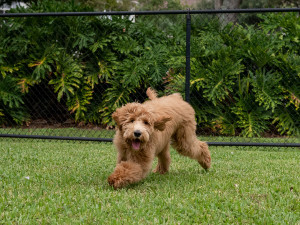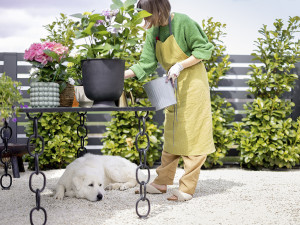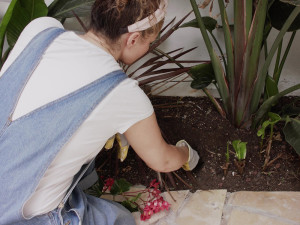Tips on Dog-Safe Gardening
Garden organically, for the sake of both the planet and your dogs.

Share Article
If your new pup is getting a little too interested in your garden, you’ve probably quickly realized that you’ll need to pup-proof your garden much like you did your house. A big difference in garden pup proofing is that, on the one hand, your garden needs protection from the dog, but on the other, your pet will also need to be protected from the garden. There are plenty of hazards to beware of, from tree bark to fertilizers which can be poisonous to pups. Here are a few insights on how to protect your dog in the garden:
Some Mulches and Bark Are Bad for Dogs
You don’t really want your dog to eat any tree bark because it can cause gastrointestinal irritation or, even worse, intestinal blockage. But, some tree barks and mulches are worse than others. Pet parents should avoid cocoa bean mulches; their chocolaty smell is irresistible to dogs — like a pup catnip — but they contain theobromine, which is toxic for dogs.
Cross almond or walnut trees off your list for areas used by dogs. Tannin is a canine toxin found in almonds and walnut hulls which a curious pup might get into. Moldy walnuts are also a problem. There are also fruit trees with bark toxic to dogs, such as cherry (contains cyanide-like components). Outside of poisons, some stone fruit trees (apricots, plums, peaches, nectarines) can be hazardous simply because of their indigestible pits. It might not be an issue for some dogs, but for other dogs who like to indulge in fruit, it could lead to intestinal obstruction.
Protecting Trees from Urine
Protect young trees, especially if you have a male dog. Be sure to frequently rinse the trunk and soil with fresh water. Or, secure a copper or galvanized splash guard of appropriate height and circumference around the developing tree the first couple of years to divert unwelcome attention from your pup.

Use Raised Garden Beds
Raised beds protect plantings from scampering paws and swinging tails. Dogs can be taught where they’re permitted and where they are not.
Take Care With Edible Plants
Construct a barrier around plants of the nightshade family, including eggplant, tomato and potato; their foliage and stems contain dangerous alkaloids that can kill a dog. When dogs eat large amounts of onions, they may suffer red blood cell destruction. Rhubarb leaves (Rheum rhabarbaram) contain oxalic acid. In quantity, it damages kidneys.
Some Flowers Are Poisonous to Dogs
Foxglove (Digitalis purpurea), Deadly Nightshade (Atropa belladonna), Larkspur (Delphinium ajacis) have toxic effects on the heart and circulation. Tulips, daffodils, foxglove and azaleas can all cause symptoms such as vomiting, drooling and even kidney damage when ingested by pets. Lilies are especially toxic to cats—and popular around Easter time—and can cause kidney problems, while the Sago Palm plant causes health problems such as vomiting, diarrhea and liver failure in dogs.
Watch Out for Poisonous Chemicals
Do not use snail bait containing metaldehyde, which is highly poisonous to dogs and cats. Copper barrier tape is a good alternative; slugs and snails are deterred from crossing it by the tape’s tiny positive electric charge. Rodenticides and other poisons are toxic to all animals. Avoid their use. If you have any of these products, take special care to keep them away from pets.
Fertilizers Are Dangerous to Dogs
The nitrogen, phosphorus, potassium, iron, zinc and herbicides that supplement plant growth can cause severe symptoms in pets, such as difficulty breathing, vomiting, diarrhea and intestinal blockage. Be very careful about fertilizing lawn areas where many dogs like to spend time.
Create a Dog Zone
Digging pit, preferably in shaded locations, give dogs places to practice their digging skills without disrupting your garden beds. You might entice them to use it by lightly burying (as they watch you) a treat-filled Kong. It’s also a good idea to leave a plant-free “patrolling” area around the perimeter of your yard; dogs instinctively (and repeatedly) cruise boundaries and fence lines.

Claudia Kawczynska
Claudia Kawczynska was co-founder and editor-in-chief of The Bark for 20 years. She also edited the best-selling anthology Dog Is My Co-Pilot.
Related articles
![A dog laying under a table outside while a woman cares for her plants.]()
Follow These 4 Pet-Safe Pest Control Tips for Your Summer Garden
You need to be extra careful if your dog or cat is your gardening assistant.
![Plant Kween standing in a greenhouse space wearing brightly colored pants and a beige corset top smiling in a carefree way]()
The Plant Kween Has Spoken!
We’ve got the fabulous gardener’s take on pet-friendly plants.
![goldendoodle puppy playing in grass in yard]()
The Dirt on Dog-Proofing Your Yard
10 steps to a safe outdoor space. Landscaper not required.
![A woman digging a big hole in her flower bed]()
How to Compost Your Pet’s Poop
Without getting totally grossed out.




